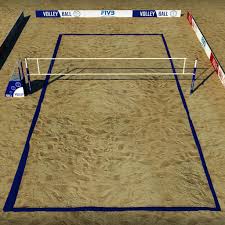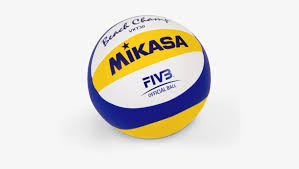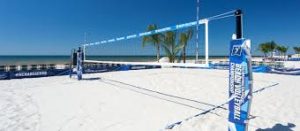
About Beach Volleyball
Beach volleyball is an outdoor team sport, played between two teams each comprising of two team players. The sport is played over in sand court usually on the sandy beach of the sea.
This is a fast-paced sport that gained popularity as a fun leisure beach activity among the sunbathers enjoying the beach.
Fédération Internationale de Volleyball (FIVB) is the governing body of this sport. They organize the international beach volleyball tournaments and publish rules of this sport every four years.
Rules governing the sport have changed since its inception, and the sport had become fast with the decrease in court size and strengthening of rules. This sport is always officiated by five officials that include two referees, a scorer and two line judges.
Beach Volleyball Olympic 2020 logo : ![]()
History
Beach volleyball originated, in 1915 as an alternative to indoor volleyball, in Waikiki Beach in Hawaii. By 1922 many clubs started playing beach volleyball, by 1924, inter-club competitions started.
During that period the beach volleyball was played with three players on each side. In 1930, Santa Monica Athletic club coach Johnson decided to go along with two players on each side after waiting long enough for the players to show up.
The popularity of two players on each side became popular across the clubs. The team comprised of players who are fast and agile. The 1960s saw a surge in the popularity of this sport across the globe.
Beach volleyball has been included in Olympics from the 1996 Atlanta Olympics and had been part of the Olympics since then. This sport is governed by Fédération Internationale de Volleyball (FIVB), that has five regional governing bodies, for its assistance.
Objective
The objective of the game is to send the ball into the other side of the net to the opponent’s court so that the ball hits the ground, thus receiving points in return.
The game is played, in sets with each set comprising of 21 points. The team that reaches 21 points first with a two-points advantage is awarded the set.
The team winning two sets is declared, as the winner. When the two teams are tied with one set each, the third set is played and the team reaching 15 points first is awarded the set.
The team should have a two-point advantage over their opponent for winning a set. The set continues until a team has clear two points advantage over their opponent.
Players go to great lengths to keep the ball from hitting the sand in their court and try to send the ball back to the opponent’s court.
Equipments
The equipment required for beach volleyball is the court, net and the ball.
Court: This sport is played, in sand court; the sand should be 40 centimetres in-depth inside the court and should be devoid of any potential hazard for players like rocks or any sharp substances or garbage that could injure the players. The sand is levelled evenly inside the court.
The Beach Volleyball is played in a rectangular court measuring 16 m by 8 m divided into two halves. Each half measure 8m by 8m. The court is surrounded, by 3 m wide vacant space on each side.
The lines are made, from hard plastic, 5 centimetres wide with a bright colour to help players and line judges to locate the line, amidst the sand.
Ball: The ball used in Beach Volleyball, is spherical and made of water-resistant material. They are always brightly coloured and have a circumference of 68 centimetres and weigh about 280 gms.
 Net: A net measuring 2 m 43 centimetre in height is used for men’s event while women’s event has a net measuring 2m 24 centimetres in height. The net is connected, to two antennas that are considered part of the extended net.
Net: A net measuring 2 m 43 centimetre in height is used for men’s event while women’s event has a net measuring 2m 24 centimetres in height. The net is connected, to two antennas that are considered part of the extended net.
The length of the net is 28 feet and has a referee stand beside the net stand. The net is made, of strong nylon or synthetic material strong enough to withstand ball with high speeds. It is also bordered, on top and bottom with 4-inch-wide canvas.

Match Officials
As in all other sports, Beach volleyball match is governed, by match officials that have respective roles.
First Referee: The first referee stands beside the net flag and controls the fast-flowing game, and has the final say to settle all the disputes arise during the game.
Before the match, it is the responsibility of the referee to check all the playing equipment. Once the first referee makes a call, neither player nor another referee can argue with that decision.
Second Referee: The second referee helps in assisting the first referee throughout the game. In case the first referee had to leave the match, the second referee assumes the position of the first referee.
Line officials: Line judges stand in the opposite corners of the court to check whether the ball lands inside the court or outside. They assist the first referee with their decision.
Scorer: The scorer keeps track of the score of each team during the match.
Terms Associated
Blocker: A blocker should be tall, having the jumping ability and precise knowledge of timing. Stationed in the front of the net, they block any attack from the opponents.
Defender: The defender is positioned at the back of the court to respond to hard drive or softball thrown in by the opponent team.
Serve: Each point starts with a serve; serve starts from the back of the court. The player can deploy any kind of serve, like float serve, jump serve or underhand serve. The objective of serve is to send the ball over the net into the opponent’s court.
Passing: Passing means passing the ball within the team for proper clearance over the net to the opponent’s court. The hand setting standard is stricter for Beach volleyball; players cannot use their figures for receiving the serve.
Spike: A spike involves hitting the ball with one hand in a downwards trajectory from above the net.
Shot: Shot is a soft attack to place the ball into a vacant portion of the opponent’s court.
Rally: A rally involves back and forth of the ball by players of each team over the net to pass the ball to the opponent court. The rally ends, when one team fails to return the ball over the net, or the ball lands outside the court or due to any other fault.
Players Safety
- As beach volleyball, is played outdoors in the sand court and in the open sun, there are safety measures to be adhered by the players.
- The players can wear sports shoes to protect their feet from the burning sand as the sand tends to get warmer with the sun. Though many players like to play barefoot.
- Players can protect their eyes by wearing sunglasses amidst sun's rays. Players can also wear caps for protecting their face.
- Players can wear kneepads for protecting their legs from injury while diving.
- Players can apply sunscreem for protecting their body against sun.
- Players can wear elbowguards for protecting their elbows from scratching in sand.
Scoring
- Team is awarded a point when a rally ends. Each new point starts with a serve by a team. Points is awarded to the opponent team when a team fails to return the ball, or ball is placed out of the playing court.
- A point is awarded to the team when opponent team commits a fault. If both teams commits the fault simultaneously, then the point is replayed.
- The points accumulated by a team gets added in the set, and the team reaching 21 points first is handed the set.
- The set continues until a team has clear two points advantage over their opponents on reaching 21 points.
- When two teams are tied with ne set each, the third set is played and the team reaching 15 points first is awarded the set. the team should have two points advantage over their opponent for winning the set. Theset continues until a team has a clear two points advantage over their opponent.
- Team winning two sets is declared as the winner.
Rules Of Beach Volleyball
- The game begins with the toss. The winner of the toss has the option of choosing to serve or to receive the serve.
- Each team should have two team players intheir team during the match. No player substitution is allowed in this sport.
- Each team can touch the ball a maximum of three times before sending it back to the opponent's court.
- Ball landing on the line is considered to be landing in the court.
- Blocking the ball counts as one of the permissible three contacts.
- After blocking the ball, any player can make the first contact with the ball.
- If the ball lands out of the court, the last team to touch the ball is at fault.
- Players are not alowed to catch, carry or throw the ball during play.
- When the ball is hit with one hand, then it must be from the heel of the palm or back of the hand from wrist from wrist to knuckles.
- Hand placement, or re-direction of the ball with fingures is a fault.
- A serve that touches the net is a fault.
- There is no set position for the players. They can move to any part of the court on their side.
- Crossing the center line and interfering with an opponent during the continuation of the match is a fault.
- Player's body or uniform is not allowed to touch the net.
- In this sport, it is perfectly legal to cross under the net, if it does not interfere with an opponent's attempt.
- The teams switches the sides of the court whenever the combined score of both the teams is in multipl;e of seven. In the last set however, the teams switches the side of the court when the combined score of both the teams is in the multiple of five.
World Rankings
- World rankings based on teams standings
- Mens Team
- Mol A/Sorum C

- Stoyanovskiy/Krasilnikov

- Alison/Alvaro Filho

- Womens Team
- Pavan/Melissa

- Alix/April

- Agatha/Duda





 (2 votes, average: 5.00 out of 5)
(2 votes, average: 5.00 out of 5)


